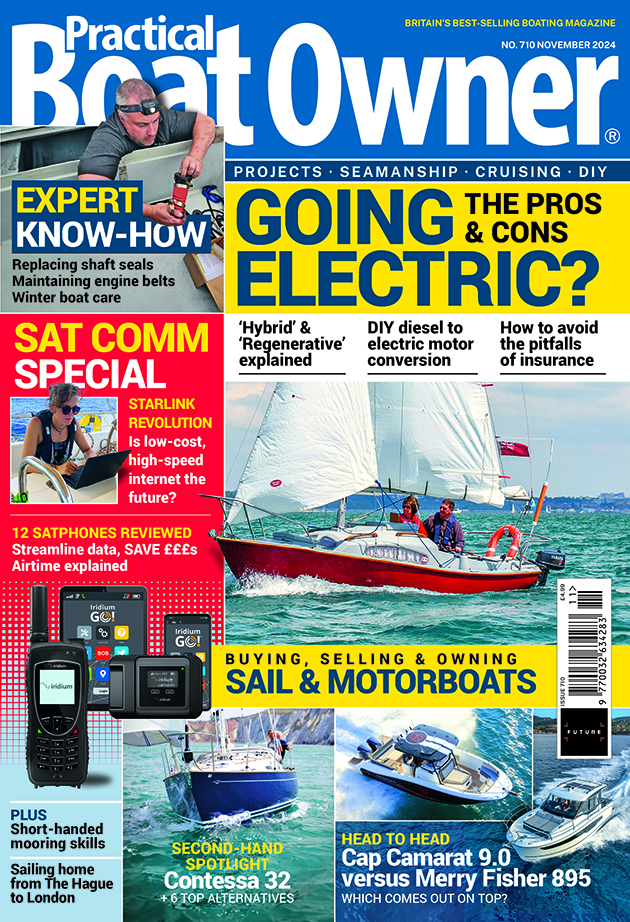There are a variety of ways to attach your mainsail luff to the mast. Which option you go for will depend on the size of your boat as well as a number of other factors. Rupert Holmes reports.
On some boats, the supposedly simple task of hoisting the mainsail can be a real struggle thanks to unnecessary friction. Often a stiff sheave at the masthead is assumed to be the problem, but the issue is more likely to be with the sail’s luff hardware be it luff slides, bolt rope or some other system.
Luff slides or slugs need to be matched to the profile of the mast’s luff groove, but on many older boats, the hardware may have been replaced with the wrong items. So it’s worth checking they are an easy fit and slide up and down without sticking.
Luff slides should be a loose fit, without risk of escaping through the luff groove.
If you know the manufacturer of the spar, and the size of the cross-section, then a rigger or sailmaker can advise on the appropriate hardware.

A traditional full slide from Allen. These do a great job on smaller yachts, but the size will need to be matched to the mast and mast groove/ track
On an older boat where manufacturer’s data may not be available, it can help to measure the width of the luff groove and the thickness of the mast tube.
Full-length battens ought to be matched with luff cars with rollers to prevent excess friction when raising or lowering the sail. This becomes more important with larger boats, especially those over around 28-30ft and most manufacturers offer cost-effective options.
For those with a bigger budget today’s roller bearing luff car systems from manufacturers such as Ronstan, Harken and Antal are seriously impressive. They make a huge difference to the effort required to hoist, reef, or lower a sail, especially on boats over around 35ft, where the loads are greater.

Seldén’s wheeled batten car will make light work of hoists and drops on bigger boats where the mainsail load is higher
Indeed I’ve sailed boats where, if the main is sheeted tight and the halyard neatly flaked, the sail will fall into the lazybag in a couple of seconds, even with the wind behind.
However, before going all out on expensive hardware it’s worth checking that any difficulties you’re experiencing aren’t caused by other problems with the existing set up that are easy to solve.
In some cases, a build-up of dirt and grime can result in extra friction, so simply cleaning the luff groove can be a help. For this, I usually use a short length of old rope soaked in a solvent such as meths or white spirit.
Tie a bowline in each end of the line and an overhand knot in the middle. The centre knot gets fed behind the luff groove at the gate for the sail slides, and the two ends attached to the main halyard and a downhaul. Finish off with a squirt of dry lubricant (or silicon lubricant) on the slides.
On smaller boats, mainsail slides can be attached to the sail with a plastic shackle. However, larger craft, or those destined to sail well offshore, will benefit greatly from a substantial sewn webbing attachment – this will provide much greater longevity and reliability.
As well as being easier to hoist the main, eliminating as much friction as possible also makes it easier to reef.
15 boat fixes at sea: sailors share how to deal with torn sails, rudder damage, chafe & more
Transatlantic sailors tell Ali Wood how they used their ingenuity – and sometimes bravery – to cope with emergencies on…
Quiz a sailmaker – everything you need to know about sails
Whilst deciding what cut and sailcloth to chose for the PBO Project Boat, we quizzed technical manager Daryl Morgan from…
How to measure your yacht for new sails
Measuring your boat for new sails is a job for the sailmaker, so when our PBO Project Boat Maximus needed…
Boat sails: how to make them last longer
David Bond gets professional tips for prolonging the life of his boat sails
Want to read more articles like Luff slides and fittings: how to pick the best?

A subscription to Practical Boat Owner magazine costs around 40% less than the cover price.
Print and digital editions are available through Magazines Direct – where you can also find the latest deals.
PBO is packed with information to help you get the most from boat ownership – whether sail or power.
-
-
-
- Take your DIY skills to the next level with trusted advice on boat maintenance and repairs
- Impartial in-depth gear reviews
- Practical cruising tips for making the most of your time afloat
-
-
Follow us on Facebook, Instagram, TikTok and Twitter








